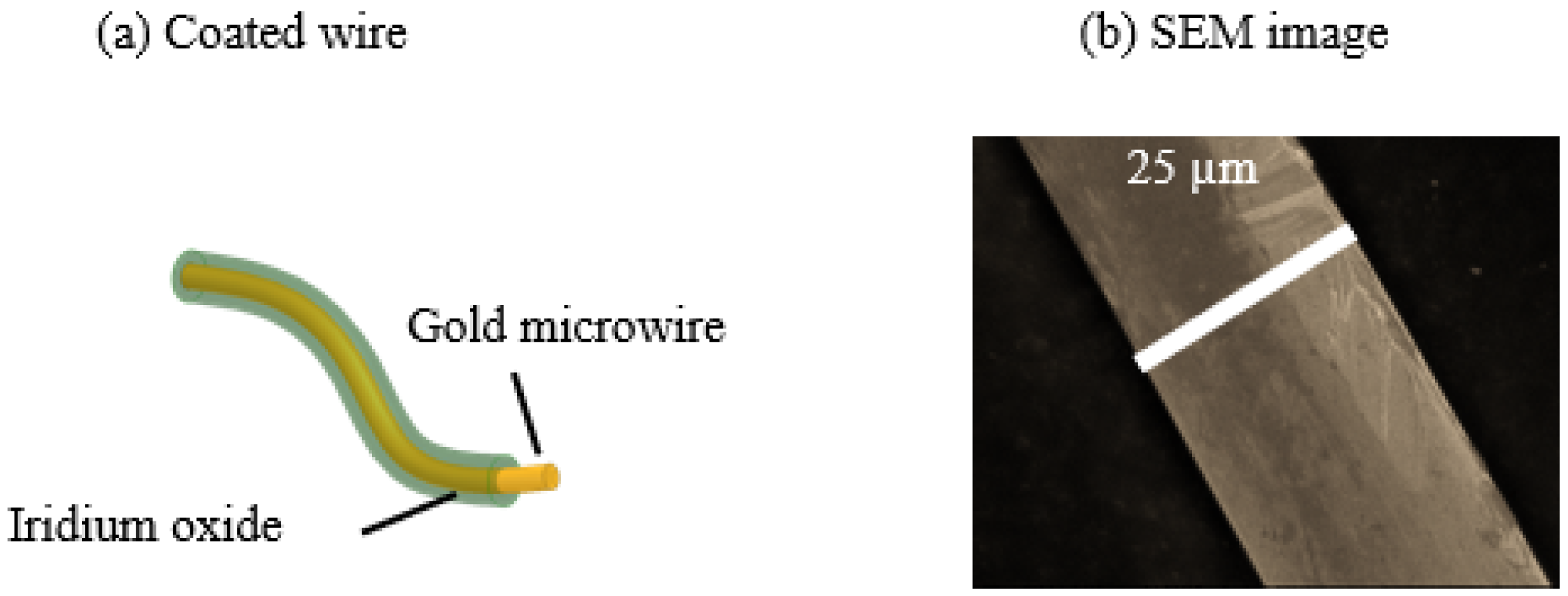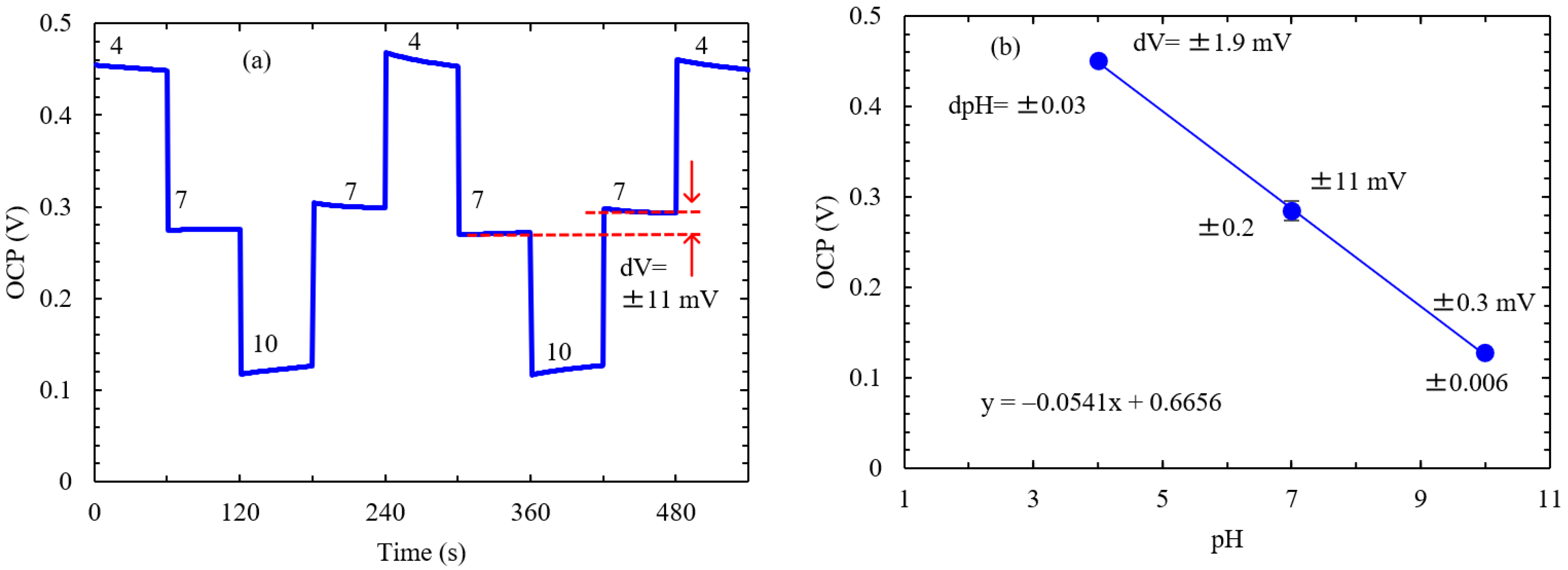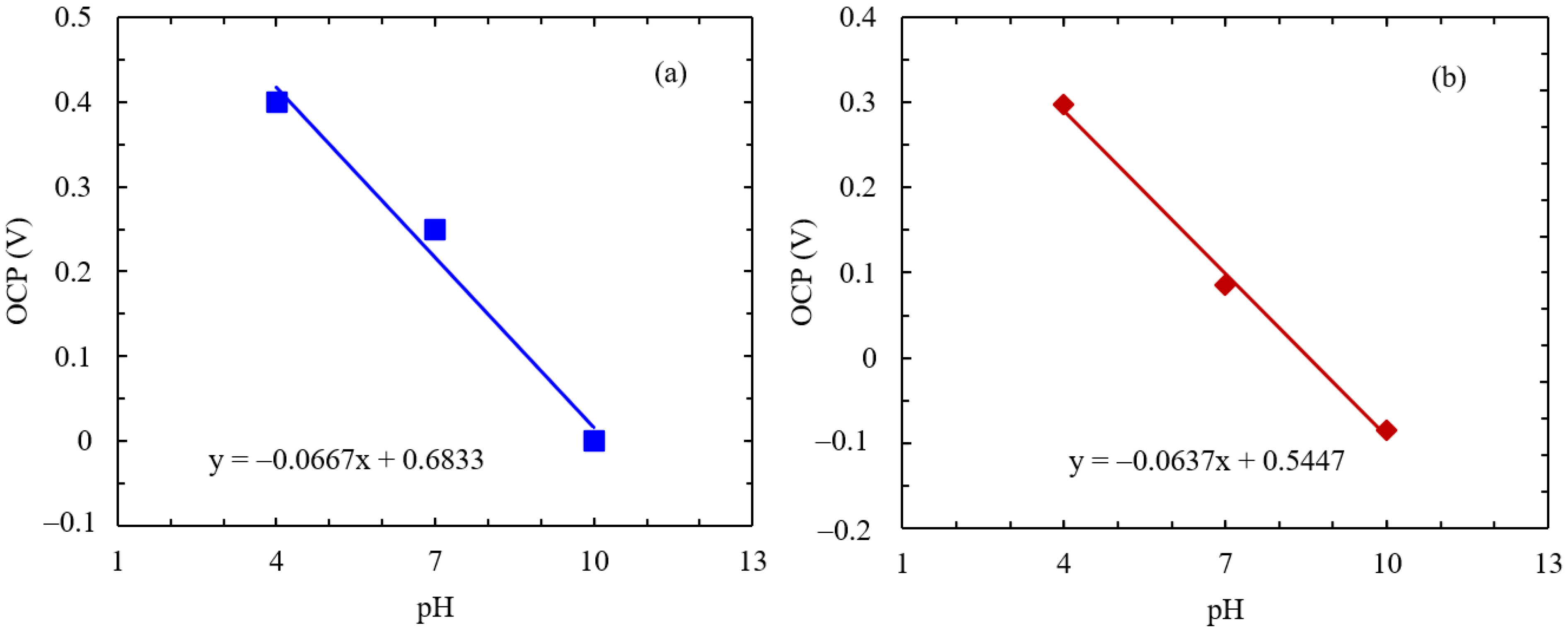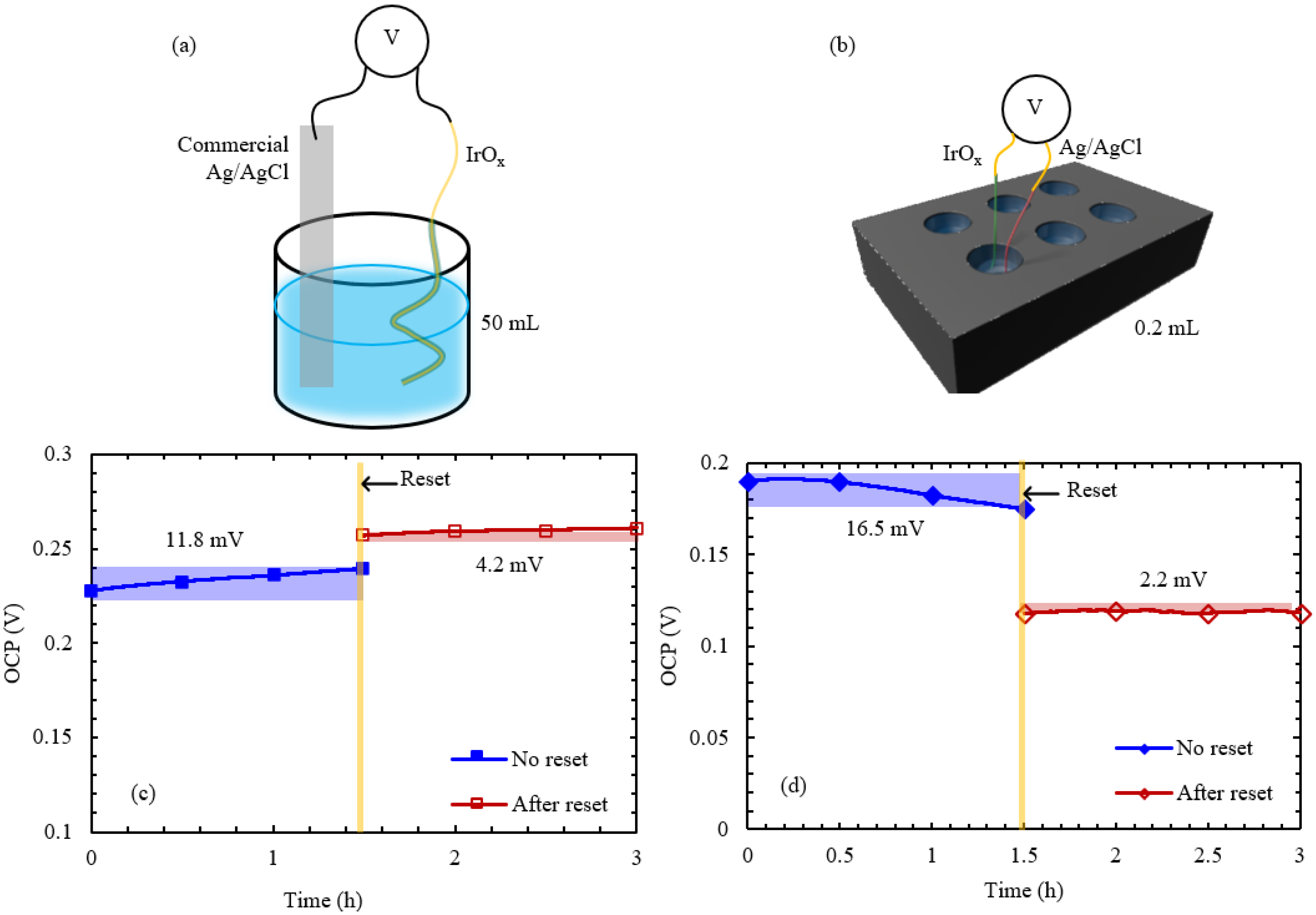Miniaturized Iridium Oxide Microwire pH Sensor for Biofluid Sensing
Abstract
:1. Introduction
2. Materials and Methods
3. Results and Discussion
3.1. pH-Sensing Performance by Open-Circuit Potential Measurement
3.2. pH-Sensing Performance by Cyclic Voltammetry
3.3. Potential Drift Study
3.4. Microwires in Small-Volume Sensing
4. Conclusions
Author Contributions
Funding
Institutional Review Board Statement
Informed Consent Statement
Data Availability Statement
Conflicts of Interest
References
- Husabø, G.; Nilsen, R.M.; Flaatten, H.; Solligård, E.; Frich, J.C.; Bondevik, G.T.; Braut, G.S.; Walshe, K.; Harthug, S.; Hovlid, E. Early diagnosis of sepsis in emergency departments, time to treatment, and association with mortality: An observational study. PLoS ONE 2020, 15, e0227652. [Google Scholar] [CrossRef]
- Ganesh, K.; Sharma, R.N.; Varghese, J.; Pillai, M. A profile of metabolic acidosis in patients with sepsis in an Intensive Care Unit setting. Int. J. Crit. Illn. Inj. Sci. 2016, 6, 178–181. [Google Scholar] [CrossRef] [PubMed]
- Kaya, T.; Liu, G.; Ho, J.; Yelamarthi, K.; Miller, K.; Edwards, J.; Stannard, A. Wearable sweat sensors: Background and current trends. Electroanalysis 2019, 31, 411–421. [Google Scholar] [CrossRef]
- Yang, X.; Pan, X.; Blyth, J.; Lowe, C.R. Towards the real-time monitoring of glucose in tear fluid: Holographic glucose sensors with reduced interference from lactate and pH. Biosens. Bioelectron. 2008, 23, 899–905. [Google Scholar] [CrossRef] [PubMed]
- Zuliani, C.; Matzeu, G.; Diamond, D. A potentiometric disposable sensor strip for measuring pH in saliva. Electrochim. Acta 2014, 132, 292–296. [Google Scholar] [CrossRef]
- Prats-Alfonso, E.; Abad, L.; Casañ-Pastor, N.; Gonzalo-Ruiz, J.; Baldrich, E. Iridium oxide pH sensor for biomedical applications. Case urea–urease in real urine samples. Biosens. Bioelectron. 2013, 39, 163–169. [Google Scholar] [CrossRef]
- Bariya, M.; Nyein, H.Y.Y.; Javey, A. Wearable sweat sensors. Nat. Electron. 2018, 1, 160–171. [Google Scholar] [CrossRef]
- Choi, J.; Ghaffari, R.; Baker, L.B.; Rogers, J.A. Skin-interfaced systems for sweat collection and analytics. Sci. Adv. 2018, 4, eaar3921. [Google Scholar] [CrossRef]
- Fluhr, J.W.; Elias, P.M. Stratum corneum pH: Formation and function of the ‘acid mantle’. Exog. Dermatol. 2002, 1, 163–175. [Google Scholar] [CrossRef]
- Percival, S.L.; McCarty, S.; Hunt, J.A.; Woods, E.J. The effects of pH on wound healing, biofilms, and antimicrobial efficacy. Wound Repair Regen. 2014, 22, 174–186. [Google Scholar] [CrossRef]
- Yang, Y.; Song, Y.; Bo, X.; Min, J.; Pak, O.S.; Zhu, L.; Wang, M.; Tu, J.; Kogan, A.; Zhang, H. A laser-engraved wearable sensor for sensitive detection of uric acid and tyrosine in sweat. Nat. Biotechnol. 2020, 38, 217–224. [Google Scholar] [CrossRef] [PubMed]
- Ma, D.; Chon, S.; Cho, S.; Lee, Y.; Yoo, M.; Kim, D.; Lee, D.Y.; Lim, J.K. A novel photolithographic method for fabrication of flexible micro-patterned glucose sensors. J. Electroanal. Chem. 2020, 876, 114720. [Google Scholar] [CrossRef]
- Dominiczak, J.; Krzemiński, J.; Wojcieszek, J.; Baraniecki, D.; Budny, F.; Wojciechowska, I.; Walter, P.; Pepłowski, A.; Górski, Ł.; Jakubowska, M. Aerosol-jet-printed potentiometric pH sensor for sweat measurements in smart patches. Sens. Bio-Sens. Res. 2024, 43, 100636. [Google Scholar] [CrossRef]
- Dabaghi, M.; Saraei, N.; Xu, G.; Chandiramohan, A.; Yeung, J.; Nguyen, J.P.; Vukmirovic, M.; Selvaganapathy, P.R.; Hirota, J.A. PHAIR: A biosensor for pH measurement in air–liquid interface cell culture. Sci. Rep. 2021, 11, 3477. [Google Scholar] [CrossRef]
- Terse-Thakoor, T.; Punjiya, M.; Matharu, Z.; Lyu, B.; Ahmad, M.; Giles, G.E.; Owyeung, R.; Alaimo, F.; Baghini, M.S.; Brunyé, T.T. Thread-based multiplexed sensor patch for real-time sweat monitoring. npj Flex. Electron. 2020, 4, 18. [Google Scholar] [CrossRef]
- Jia, J.; Xu, C.; Pan, S.; Xia, S.; Wei, P.; Noh, H.Y.; Zhang, P.; Jiang, X. Conductive thread-based textile sensor for continuous perspiration level monitoring. Sensors 2018, 18, 3775. [Google Scholar] [CrossRef]
- Wang, M.; Yao, S.; Madou, M. A long-term stable iridium oxide pH electrode. Sens. Actuators B Chem. 2002, 81, 313–315. [Google Scholar] [CrossRef]
- Shahrestani, S.; Ismail, M.C.; Kakooei, S.; Beheshti, M.; Zabihiazadboni, M.; Zavareh, M.A. Iridium Oxide pH Sensor Based on Stainless Steel Wire for pH Mapping on Metal Surface; IOP Conference Series: Materials Science and Engineering; IOP Publishing: Bristol, UK, 2018; Volume 328, p. 012014. [Google Scholar]
- Trovato, V.; Teblum, E.; Kostikov, Y.; Pedrana, A.; Re, V.; Nessim, G.D.; Rosace, G. Sol-gel approach to incorporate millimeter-long carbon nanotubes into fabrics for the development of electrical-conductive textiles. Mater. Chem. Phys. 2020, 240, 122218. [Google Scholar] [CrossRef]
- Faustini, M.; Louis, B.; Albouy, P.A.; Kuemmel, M.; Grosso, D. Preparation of sol–gel films by dip-coating in extreme conditions. J. Phys. Chem. C 2010, 114, 7637–7645. [Google Scholar] [CrossRef]
- Lee, I.; Whang, C.; Choi, K.; Choo, M.; Lee, Y. Characterization of iridium film as a stimulating neural electrode. Biomaterials 2002, 23, 2375–2380. [Google Scholar] [CrossRef]
- Shinwari, M.W.; Zhitomirsky, D.; Deen, I.A.; Selvaganapathy, P.R.; Deen, M.J.; Landheer, D. Microfabricated reference electrodes and their biosensing applications. Sensors 2010, 10, 1679–1715. [Google Scholar] [CrossRef] [PubMed]
- Chawang, K.; Bing, S.; Chiao, J. Printable and flexible iridium oxide-based pH sensor by a roll-to-roll process. Chemosensors 2023, 11, 267. [Google Scholar] [CrossRef]
- Huang, W.; Cao, H.; Deb, S.; Chiao, M.; Chiao, J.-C. A Flexible pH Sensor Based on the Iridium Oxide Sensing Film. Sens. Actuators A Phys. 2011, 169, 1–11. [Google Scholar] [CrossRef]
- Hopkins, E.; Sanvictores, T.; Sharma, S. Physiology, Acid Base Balance; StatPearls Publishing: Treasure Island, FL, USA, 2018. [Google Scholar]
- Shin, P.; Ryssel, H. pH Sensing Properties of ISFETs with LPCVD Silicon Nitride Sensitive-Gate. J. Electr. Eng. Inf. Sci. 1997, 2, 82–87. [Google Scholar]
- Olthuis, W.; Robben, M.; Bergveld, P.; Bos, M.; Van der Linden, W.E. pH Sensor Properties of Electrochemically Grown Iridium Oxide. Sens. Actuators B Chem. 1990, 2, 247–256. [Google Scholar] [CrossRef]
- Chawang, K.; Xia, X.; Huang, M.-H.; Bing, S.; Benomar, M.; Doan, G.; Cao, H.; Chiao, J.-C. Improvement on Potential Drifting for Sol–Gel and Electroplated Iridium Oxide-Based pH-Sensing Films. IEEE Sens. Lett. 2023, 7, 2001504. [Google Scholar] [CrossRef]
- Yang, X.; Chawang, K.; Chiao, J.-C. Wearable Iridium Oxide pH Sensors for Sweat pH Measurements. In Proceedings of the IEEE Sensors Conference, Montreal, QC, Canada, 27–30 October 2019. [Google Scholar]








Disclaimer/Publisher’s Note: The statements, opinions and data contained in all publications are solely those of the individual author(s) and contributor(s) and not of MDPI and/or the editor(s). MDPI and/or the editor(s) disclaim responsibility for any injury to people or property resulting from any ideas, methods, instructions or products referred to in the content. |
© 2024 by the authors. Licensee MDPI, Basel, Switzerland. This article is an open access article distributed under the terms and conditions of the Creative Commons Attribution (CC BY) license (https://creativecommons.org/licenses/by/4.0/).
Share and Cite
Chawang, K.; Bing, S.; Kwon, K.Y.; Chiao, J.-C. Miniaturized Iridium Oxide Microwire pH Sensor for Biofluid Sensing. Chemosensors 2024, 12, 168. https://doi.org/10.3390/chemosensors12080168
Chawang K, Bing S, Kwon KY, Chiao J-C. Miniaturized Iridium Oxide Microwire pH Sensor for Biofluid Sensing. Chemosensors. 2024; 12(8):168. https://doi.org/10.3390/chemosensors12080168
Chicago/Turabian StyleChawang, Khengdauliu, Sen Bing, Ki Yong Kwon, and J.-C. Chiao. 2024. "Miniaturized Iridium Oxide Microwire pH Sensor for Biofluid Sensing" Chemosensors 12, no. 8: 168. https://doi.org/10.3390/chemosensors12080168





